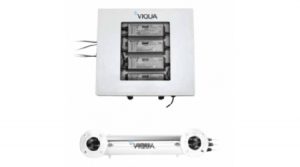What is the Difference Between Oxidizers and Disinfectants?
 The terms oxidizer and disinfectant are often confused and used inaccurately. Here is the difference between oxidizers and disinfectants. This is useful information when considering the control of Legionella and other opportunistic waterborne pathogens.
The terms oxidizer and disinfectant are often confused and used inaccurately. Here is the difference between oxidizers and disinfectants. This is useful information when considering the control of Legionella and other opportunistic waterborne pathogens.
Oxidizers
An oxidizer is a substance that has the ability to accept the electrons or other substances, or “oxidize” them. Strong oxidizers can oxidize the cell membrane of microorganisms, which results in a loss of structure and leads to cell lysis and often death. In doing so, they are disinfecting.
Disinfectants
Disinfectants kill germs such as certain bacteria, viruses, mildews, or fungi and are regulated by the EPA. They kill microbes by destroying their cell walls or interfering with their metabolism.
Types of Disinfectants
Disinfectants can be split into two broad groups: oxidizing disinfectants and nonoxidizing disinfectants. Oxidizing disinfectants include the halogens, chlorine, iodine, bromine, and chlorine dioxide, and oxygen-releasing materials such as peracetic acid and hydrogen peroxide. Nonoxidizing disinfectants included quaternary ammonium compounds, amphoterics, biguanides, and acid anionics.
So how do oxidizers and disinfectants relate to each other?
Strong oxidants are a type of disinfectant. In fact, oxidizing disinfectants (chlorine, chloramines, and ozone) are the final barrier in the Environmental Protection Agency-recommended multibarrier approach to providing pathogen-free water to the consumer.
Not every disinfectant is an oxidizer, but all strong oxidizers are disinfectants.
Learn more about the best approaches for controlling Legionella and other pathogens by contacting Legionella Control Systems.







